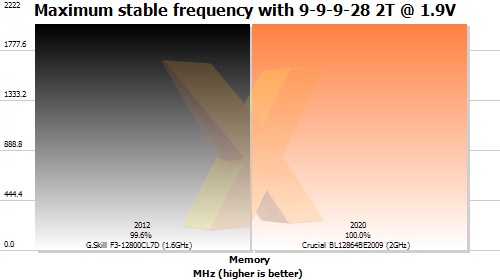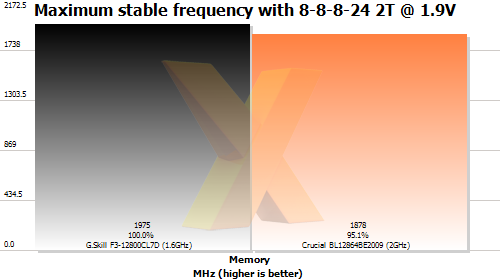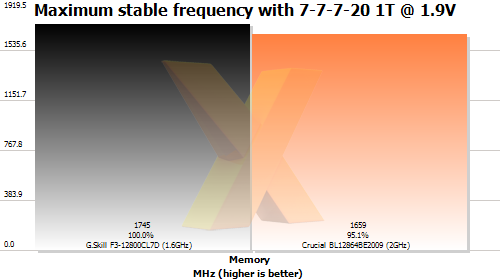Frequency scaling and temps
So there's nothing much to choose between the pair in our range of memory-intensive benchmarks, indicating, once again, that the CPU, with a 1.6GHz FSB, doesn't gain from ultra-high-speed DDR3.Reducing the latencies at any given MHz is one method of gaining extra performance. Testing was thus carried out using 9-9-9-28 (2T), 8-8-8-24 (2T), and 7-7-7-20 (1T) timings with the maximum stable speed over a 30-minute stress-test recorded for each pack.

At the relaxed 9-9-9-28 2T setting, which is the Crucial's native setting, we see that the G.SKILL modules were able to hit just over 2GHz at 1.9V. Our Crucial pack didn't have much extra headroom, though.

Knocking the latencies down to 8-8-8-24 and keeping the same 1.9V pumping through them, the Crucial begins to lag significantly behind the G.SKILL - surprising given that it's twice the price. The Crucial DRAM is tuned for high frequencies at the cost of latency, it seems.

Bringing it down to 7-7-7-20 with the performance-enhancing 1T command rate enabled, both sets hit over 1.6GHz, but the G.SKILL keeps an impressive 86MHz lead over the Crucial.
Summary
The sample G.SKILL F3-12800CL7D operates at up-to 2GHz with relaxed latencies but can be tuned to run slower with more-aggressive timings. Crucial ratifies 2GHz operation in nForce 790i Ultra SLI boards but is frequency-compromised once the latencies are reduced.
Both DDR3 sets suffer from the inability of the host system to fully leverage the bandwidth they offer, though.
Temperature musings
We ran both modules at their specified frequencies and voltages, to see just how effective their heatspreaders were at removing the build-up of localised hotspots and heat in general.| Memory | G.Skill F3-12800CL7D (1.6GHz) | Crucial BL12864BE2009 (2GHz) |
|---|---|---|
| Ambient temperature | 22°C | 23.5°C |
| Temp after 30m test | 36°C | 39°C |
| Ambient-to-load delta | 14°C | 15.5°C |
Both run surprisingly cool, intimating well-designed heatspreaders or, looking at it another way, a lack of heat transfer from the ICs.









